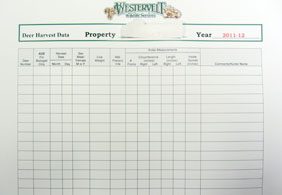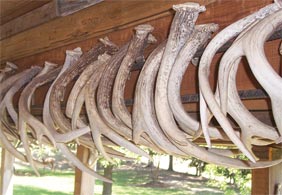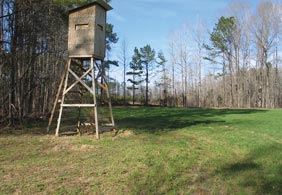Deer Data Collection – Essential for a Successful Management Program
Accurate and reliable data provide hunters and deer managers valuable insight into what is going on with their deer herd. How can you expect to have a successful deer management program without having the information needed to make sound management decisions? Without data, how do you know when its time to take it to the next level? Deer data is typically broken down into two categories: harvest and observation data. In this article, we’ll go through each category and how to put it all together to see the big picture.
Harvest Data
As the name implies, this is data taken from harvested animals. Standard data collected includes date, sex, age, weight, lactation, fetal age (if in an area where you can get measurable fetuses from does during hunting season), and antler measurements. It is essential to have a standardized procedure to ensure ALL information from EVERY deer is captured because this will be your database to use for monitoring current management strategies. Once compiled and analyzed, harvest data provides insight to herd health, age structure, sex ratio, and fawn production.

If you have an early rut, fetal data can be collected. Collected fetuses can be aged by measuring their rump to crown length. Thus allowing you to determine the date of conception, peak conception dates (peak of the rut) and the range of the breeding season (this will tell you when you need to schedule your vacation days!). Fetal data can also provide insight to the herd’s productivity and adult sex ratio, which aids in setting harvest goals. By determining the length of the breeding season, you can get an idea of whether the sex ratio in your deer herd is skewed. For example, if you collect fetuses that represent conception dates ranging from November through January, this may tell you your sex ratio is out of balance and that you need to step up your doe harvest. Does that are not bred during their first “heat” cycle will continue to come into heat (usually about 30 days later) until they are bred, thus lengthening the breeding season. You want the breeding season to occur in a narrow window, which will limit the incidence of post-rut mortality for your bucks as well as ensure fawns will be born in a relatively tight timeframe.
Don’t be too hasty in abandoning harvest restrictions or a management program based only on a couple years’ worth of data It can take several hunting seasons to produce a set of harvest data from which you can begin to identify trends. Initially smaller properties may have to pool data from adjoining properties until they have a dataset with sample sizes large enough to show statistical as well as biological trends. The data most commonly tracked from year to year is total deer harvested, weights, lactation rates, and antler measurements. Let’s go through the basics about each of these important areas.
The total number of deer harvested can be broken down by sex and age class. From this we can track historical harvest (number of bucks and does) and the age composition of the bucks and does harvested. You will need to keep in mind that several factors can affect deer harvest trends. For example, good mast years usually result in a lower number of deer harvested. This is not an indicator there are less deer, it means that deer observations were lower and thus harvest rates decreased. These factors should be noted from year to year so that rash decisions are not made based on a small window of information. This data will show us if we are meeting our harvest goals, if we need to better protect young bucks, or if we need to increase/maintain the doe harvest.
Deer weights are usually presented as averages by sex and age class. It is broken down by sex and age class because obviously bucks will weigh more than does and older deer will generally weigh more than younger deer. By comparing weights over time, you can assess herd health status. For example, if you begin to see a decreasing trend in weights, you may have more deer than the habitat can support and need to increase your doe harvest. Yearling buck weights are the best indicator of herd health, but few should be taken in a QDM program. Given the fact mature buck weights will fluctuate greatly during the season (rut), doe weights should be used as an indicator of herd health.
Lactation rates reflect the percentage of does that are “with milk”. If there is milk present, then that indicates that the doe successfully raised a fawn that year. Lactation data is not accurate for areas with early fawning dates (Florida) because fawns are usually weaned by hunting season. Reproductive rates vary among different age classes – yearling does usually have a lower reproductive rate than adult does. This creates the need to separate lactation rates for yearlings and adults. Declines in adult lactation rates can be an indicator of herd health or habitat problems. However, a high incidence of yearling lactation is an indicator of high herd productivity because that means some does are breeding as fawns.

Collecting age and antler measurement information is essential to monitoring the effectiveness of antler restrictions and management strategies. Common antler measurements taken are inside spread, beam length, basal circumferences, and number of points. However, intense deer management programs commonly measure and track the Boone & Crockett score from each buck harvested. Most serious deer hunters and managers talk in terms of Boone & Crockett scores. Boone & Crockett scores by age class can provide better insight to buck quality than standard antler measurements alone because the scores are calculated based on inside spread, beam length, tine length, and circumference measurements. This data can help you set buck harvest restrictions by giving you average antler characteristics by age class for your individual property. For example, if your management goal is to produce and harvest 130-class bucks, you will be able to see at what age (on average) bucks reach this score by having a database of harvest data. Taking photographs of each buck harvested is a good way to visually assess antler quality. You should separate the photos by age and over time you can develop a portfolio of management successes that will be a good selling feature for recruiting new club members.
Managers should look for unexplained shifts in age structure or sex ratio, decreases in age- and sex-specific body weights, decreases in lactation rates, and changes in antler quality by age class because these are signs that something is going on with the deer herd. When possible try to get data from adjoining or surrounding clubs. Explaining your goals may lead to the creation of cooperatives, which allows you to increase the size of your dataset to get a better idea of what is happening on a landscape level.
Droptine Hunting Club in Greene County, Alabama inherited a lease that had been poorly managed in the past. Even though poor prior management decisions were made, the previous club did collect pretty good harvest data. With that data, the hunters on Droptine Hunting Club quickly noticed a high percentage of 2.5 year old bucks making up the annual buck harvest and the overall harvest had been decreasing over the past few seasons. Based on this historical harvest information the club had a basis or starting point to begin building upon. From there they were able to identify what it was going to take from a deer harvest standpoint to be able to achieve their management goals. Droptine is now in year three of their management program and are starting to reap the benefits of their hard work and dedication to their management plan. By having good data collection habits, the club can now support hunter observations of perceived increased quality of the deer herd. Increases in buck quality, doe weights, and lactation rates are now showing up at the skinning shed, which are all signs of a thriving deer herd.
Observation Data
If collected properly, observation data can be another valuable piece of the deer management puzzle. This data provides additional insight into sex ratio, herd productivity, age structure, and hunt quality. Again after a few years of good data collection, we can begin to see trends in herd and hunting quality on a property. Observation data can help plan for future, more productive stand sites as well as re-educate hunters on which deer they should be harvesting.
Observation data can be analyzed in several ways but here are a few of the more common areas tracked: deer observed per hour, buck to doe ratio, when you hunt vs. deer observations, hunting time vs. buck observation rate, hunting pressure by stand, and a breakdown of hunting locations (food plot, woods, etc.).
The number of deer observed per hour is pretty self-explanatory. This can give you an idea of deer abundance and can also be an indicator of hunt quality (depending on goals). Capturing the number of hunting hours is critical because without a way to quantify the observations, incorrect conclusions can be made based on observations alone. The number of deer observed per hour can easily be broken down by sex, age, and quality and each can be analyzed separately.
The observed buck to doe ratio can be averaged over the entire season to get an overall observed sex ratio. These ratios can also be separated out by month to identify when the rut occurs, which is the best time to get an accurate estimate of the adult sex ratio. This is another method for hunters and managers to identify needed changes (increased buck protection or doe harvest) in a management program.

An interesting area of observation data is tracking hunting pressure on a property. These data include when you hunt vs. deer observations, hunting time vs. buck sightings, hunting pressure by stand, and a breakdown of hunting locations (% hunting food plots, etc.). This is becoming an important area to focus on because hunting pressure and methods have a drastic effect on deer movement and observations. Some of today’s hunters have become creatures of habit. They have one or two “favorite” stands they will hunt regardless of wind direction or past hunting pressure. If deer do move through these areas, more than likely it will be when you aren’t there. Often times these are the first people to complain about a management approach because they are not seeing any deer. When in reality they would have more successful hunts if they changed their hunting tactics. Data on hunting pressure can help prevent making incorrect conclusions about the success or failure of a management plan. By tracking pressure, managers will most likely know if it is a biological problem or a hunter management problem.
The hunters on Droptine Hunting Club also had some past year’s observation data to review as well. If you remember, the harvest data was showing an obvious decrease over the last few seasons the previous club had the lease. This was reaffirmed by their observation data. The new club began to try to identify reasons behind the decrease in observations. The logical starting places were hunting pressure and hunting strategies. It did not take long to start finding the pieces of this puzzle. The previous club had stands sitting directly on food plot edges with little to no cover around them and no logical way to enter or exit the stand without spooking deer. As a result, the Droptine hunters moved stands back off the field edges into areas with some cover around them. In addition walking trails were cut in to allow hunters to enter and exit stands without spooking deer. This alone has resulted in reduced hunting pressure and increased hunting quality. They also identified trends in hunting strategies. The previous club’s hunts were taking place primarily on food plots, thus increasing the hunting pressure on the plots and decreasing deer observations. Droptine Hunting Club manages the amount of pressure put on their food plots by allowing them to be hunted only under the appropriate wind conditions. In addition, no does are to be harvested on food plots. This does make achieving doe harvest goals a little more challenging, but it’s worth it when you can sit on a food plot and routinely see mature bucks utilizing these areas during daylight hours. Droptine’s observation rates have tripled since taking over the lease and making these changes.
Hunters and deer managers need to be collecting accurate and reliable data every time they enter the stand and from every deer harvested. By utilizing harvest and observation data, management decisions can be made based on actual trends instead of what is perceived or assumed. If you are going to dedicate the time and resources into managing and hunting a property, you might as well do it right! Just like the old saying, “anything worth doing is worth doing right.”

